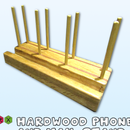Introduction: Pallet Wood Workshop Panneling With Fold Down Desk
Welcome to the hobbit's work shop, or my rather small man cave. As it's a fairly tight space, I've set out to make the most of all the wall room. With old, limestone walls, and low ceilings, I've gone down the route of turning wall space into storage space.
Needing a space to sit and work (solder, sketch etc.) and having a small pile of pallet wood, I decided to add a decorative flair to one wall by panelling it with the pallet wood and adding a fold-down desk for space saving.
Step 1: Mark Out and Fix Horizontal Battons
I found fixing 3 horizontal battons to the wall - top, middle and bottom of where the pallet planks would run. - was enough for this project.
Pilot 3mm holes (wood bit) in 3 places along the planks and counter-sink them to allow the screw heads to fit flat.
Then, use a 3mm metal bit to drill through the planks into the masonry, just to mark where the drill needed to go.
After that, use a masonry bit (the width of wall plugs) to drill in, tap in the wall plugs with a hammer and use 2 inch screws to fasten the planks to the wall.
Step 2: Adding the Vertical Pallet Panels
Next up, grab your stack of pallet wood planks and pilot 3 holes like with the horizontal planks - one either end and one in the middle, in line with the horizontal panels on the wall.
I found that holding one plank up on the wall (for reference), marking and drilling a hole central to the horizontal bars made a useful template to drill through into the remaining planks. Voila! Perfectly lined up holes every time!
Don't forget to countersink those holes and use inch long 2mm shaft wood screws to secure them in place on the wall panels.
Stand back and admire the character all those pallet planks give to your previously bare wall! Mmmmmmm, woooood!
Step 3: Optional: Sandy Sandy...
I decided at this point to give the finished wall a good sanding with my mouse sander.
On reflection, it may be easier to sand all the planks before you mount them on the wall, but it's worth it for the smooth finish.
Step 4: Measure Height for Your Fold-down Desk
Next up, decided how high you want your desk to be. I went for a height I could comfortably work at standing, as I can make a stool for any sitting work like soldering.
Mark it up on the wall for reference, using a spirit level for level-ness (is that a word?!)
Then, measure and cut a piece of wood to size for your desk. I bought a piece of 2440x600mm laminated chipboard from B&Q and got them to cut it to the width of my pallet working wall (lovely chaps that they are).
Grab your hinges and line them up one at either end of the long edge of your piece of wood, one in the middle. You can use masking tape to hold them in place.
I measure in on the wall so the hinges' holes would straddle 2 boards - 2 holes on each board - to spread the stress.
Pilot the holes through the hinge holes and screw the screws home.
Step 5: Mount the Desk on the Wall
Next up, find something you can rest the desk's board on as it'll free up your hands to drill and screw! I used my workmate, but you could get away with a chair and books!
Level your board, checking with a spirit level and pilot holes for the outer hinges.
Once you've done that, screw home the screws, making sure the hinges have a little give on them.
Repeat with the middle hinge and then tighten all the screw home.
Give the desk a test lift and drop and your desk should hold roughly at 90 degress to the wall when it's upright!
Step 6: Adding the Supporting Ropes
To hold your desk up, I used 2 lengths of climbing rope (strong enough for a person's weight!)
At the top of the pallet wall, drill a 7mm hole (or wide enough for the rope to pass through) in the middle of the top of the left and right-most panels (see photo).
Feed the rope through and knot it off tightly.
Then, drill a 7mm hole 5cm in from the bottom left and bottom right corners of the desk board.
Next, use a jigsaw or tenon saw to cut a channel in from the side and feed the rope through the channel.
Making sure the spirit level's visible, judge how high the knot needs to be and tie it off so the desk sits at 90 degrees to the wall.
Use a lighter to melt the end and knot it it's nylon rope.
Now, repeat on the other side, not forgetting the spirit level!
Step 7: Test Out That Desk!
Flip up the desk and try it out!
Step 8: Reflections and Improvements
Pallet wall screw heads
Given time, I'd revisit the screw on the pallet wall and fill in the holes above the heads with a mixture of sawdust and PVA/wood glue to cover them up and give the wall a more 'woody' finish.
Desk screw tips
I'd probably go back and use a Dremel with a grinder attachment (or file) to remove the sharp tips of the screws poking through the desk.
Final reflections and next steps
I was really please with how the desk turned out and it is certainly strong enough to hold my tools, soldering station and other bits and bobs.
Next up, I think I'll probably use my remaining pallet wood to make some shelves, cubby holes and tool holders. Stay tuned for that Instructable later!

Participated in the
Wood Contest











